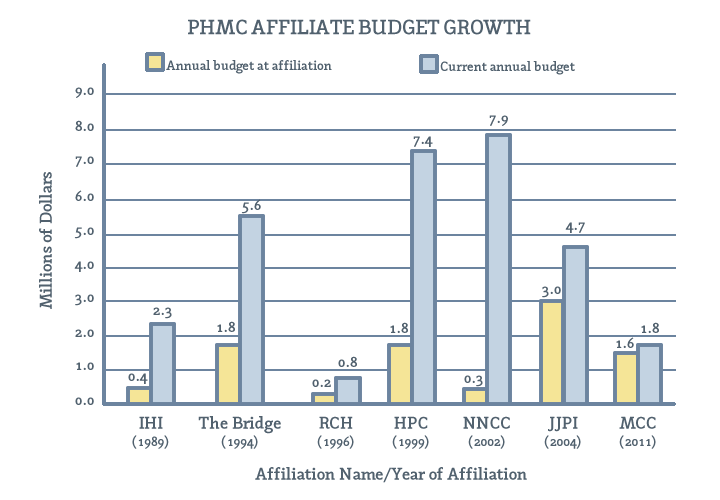Few nonprofits merge or affiliate with other nonprofits. This is in stark contrast to the private sector, where often part of business growth and development is mergers and acquisitions. When nonprofit leaders are asked in annual surveys from The Nonprofit Finance Fund and others, in spite of their financial situations, only a fraction (2–3%) of leaders respond that they are in discussions with other organizations about mergers and affiliations. For every one successful nonprofit affiliation and merger, there are hundreds that did not happen but should have. Why is this? And more important, what will it take for nonprofits to begin to work together more strategically to consolidate operations and focus on their missions?
The purpose of this article is to shed light on one organization’s affiliation model and its lessons learned as a pioneer in the nascent nonprofit affiliation and merger marketplace. Since 1989, Public Health Management Corporation (PHMC) has strategically used its infrastructure and size to partner with mission-aligned nonprofit colleagues through its affiliation model. The focus on these affiliations has been to drive down costs and enable the affiliate organizations to better focus their operational costs to better compete.
PHMC is a nonprofit public health institute that creates and sustains healthier communities using best practices to improve community health through direct service, partnership, innovation, policy, research, technical assistance and a prepared workforce. PHMC has served the greater Philadelphia region since 1972 and has become one of the largest and most comprehensive health and human services organizations in the nation. PHMC fulfills its mission to improve the health of the community by providing outreach, health promotion, education, research, planning, technical assistance and direct services.
PHMC currently has ten affiliates, of which three are support affiliates, with a consolidated annual operating budget of over $175 million, in addition to a foundation with close to $40 million in assets. Through its 250+ direct services programs and ten affiliate partner organizations, its work in emergency preparedness across the region and its various partnerships with government, foundations, businesses and community-based organizations, the work of PHMC impacts every household in the Philadelphia region. PHMC currently serves 125,000 clients. The combined annual impact of PHMC and its affiliates on the Philadelphia community’s economic vitality is estimated to be in the range of $500 million. Of every dollar received, on average 92¢, or a total of $161 million, go toward program services.
The PHMC Affiliation Model:
Affiliations are strategically different from mergers. In a merger, one of the organizations usually loses its identify and ceases to exist. Some or all staff and board leadership are absorbed into one of the organizations or the newly merged corporate entity. Affiliations are different. In this model, staff and board leadership usually remains intact following some economies of scale and back-office consolidation. In the nonprofit sector, an affiliation is similar to the relationship between a subsidiary corporation and its parent corporation. The parent corporation has some level of control; however, in general the corporations operate independently but rely on economies of scale, like common back-office services: finance, human resource, information technology and communications support.
PHMC strongly believes in the missions of the organizations with which it partners and wants them to keep their identities and leadership as they affiliate. PHMC’s management style is to stay in the background and support its affiliate organizations. The PHMC affiliation model works as follows:
- The partner agency retains its own 501(c)(3) status and federal tax ID number, files its own 990 and completes individual agency audit.
- The partner agency has its own board of directors and keeps its own assets and liabilities. There is a firewall between PHMC and the affiliate nonprofit organization.
- PHMC and the partner agency sign an affiliation agreement. The partner agency amends its articles of incorporation and by-laws to reflect the affiliation agreement and its new legal structure as a membership corporation, with PHMC as the sole member of the corporation. Within the affiliation agreement is the ability for the two organizations to part ways should the partnership not flourish. To date, PHMC has disaffiliated with two organizations, but remains connected to them in other ways like management contracts.
- Existing partner agency staff are retained; HR policies and benefits are changed to better mirror those of PHMC.
- Existing board members remain on the board of the partner agency. However, PHMC appoints two board members. PHMC has a seat for affiliate board representation on its own board.
- Following a due diligence process, which analyzes the partner organization’s need for back-office support, the partner agency enters into an annual management contract with PHMC for PHMC’s provision of information systems, fiscal, human resources, communications and marketing, program and strategy development support, quality assurance and related infrastructure services with an arms length negotiated contract for service.



